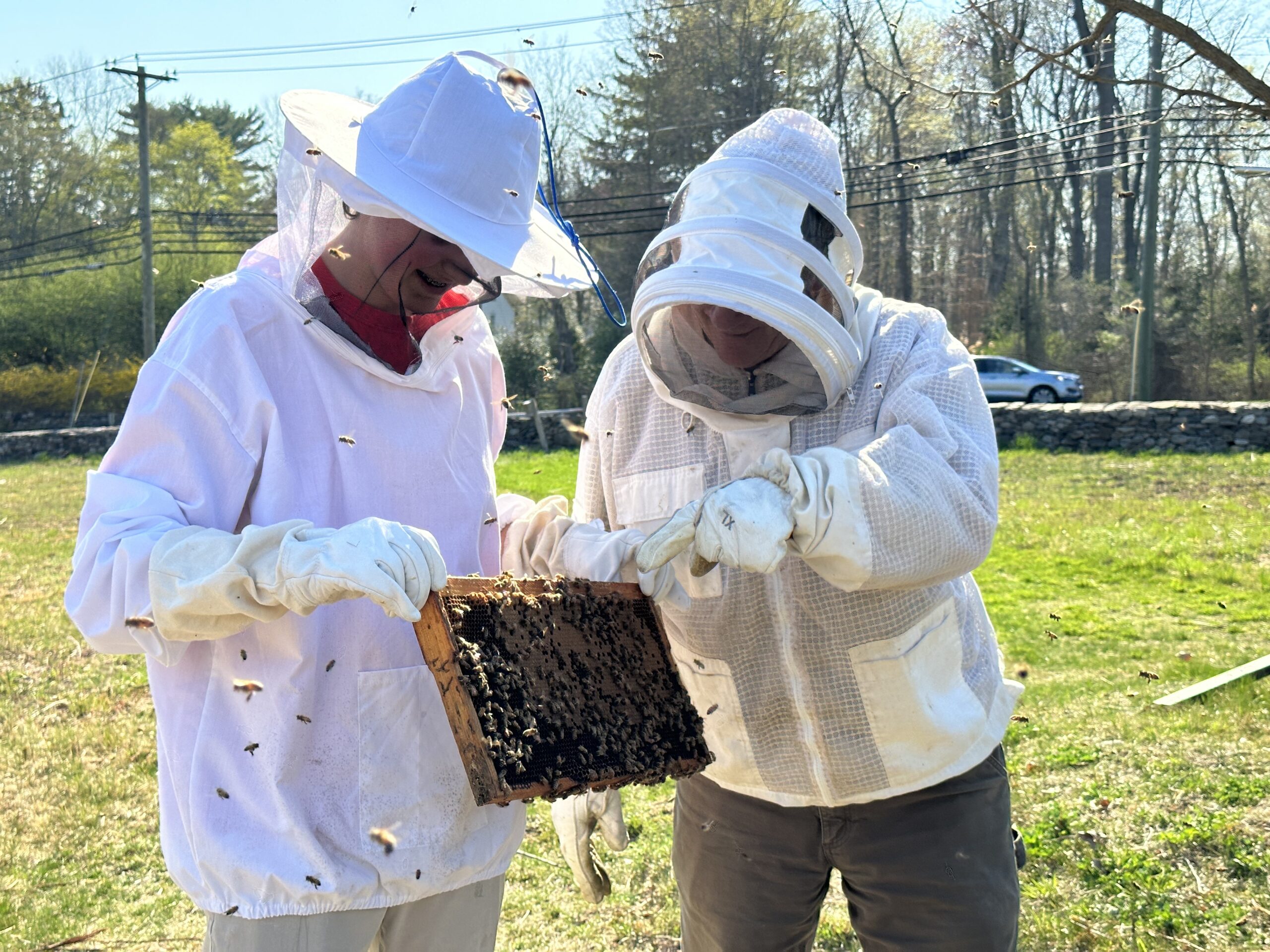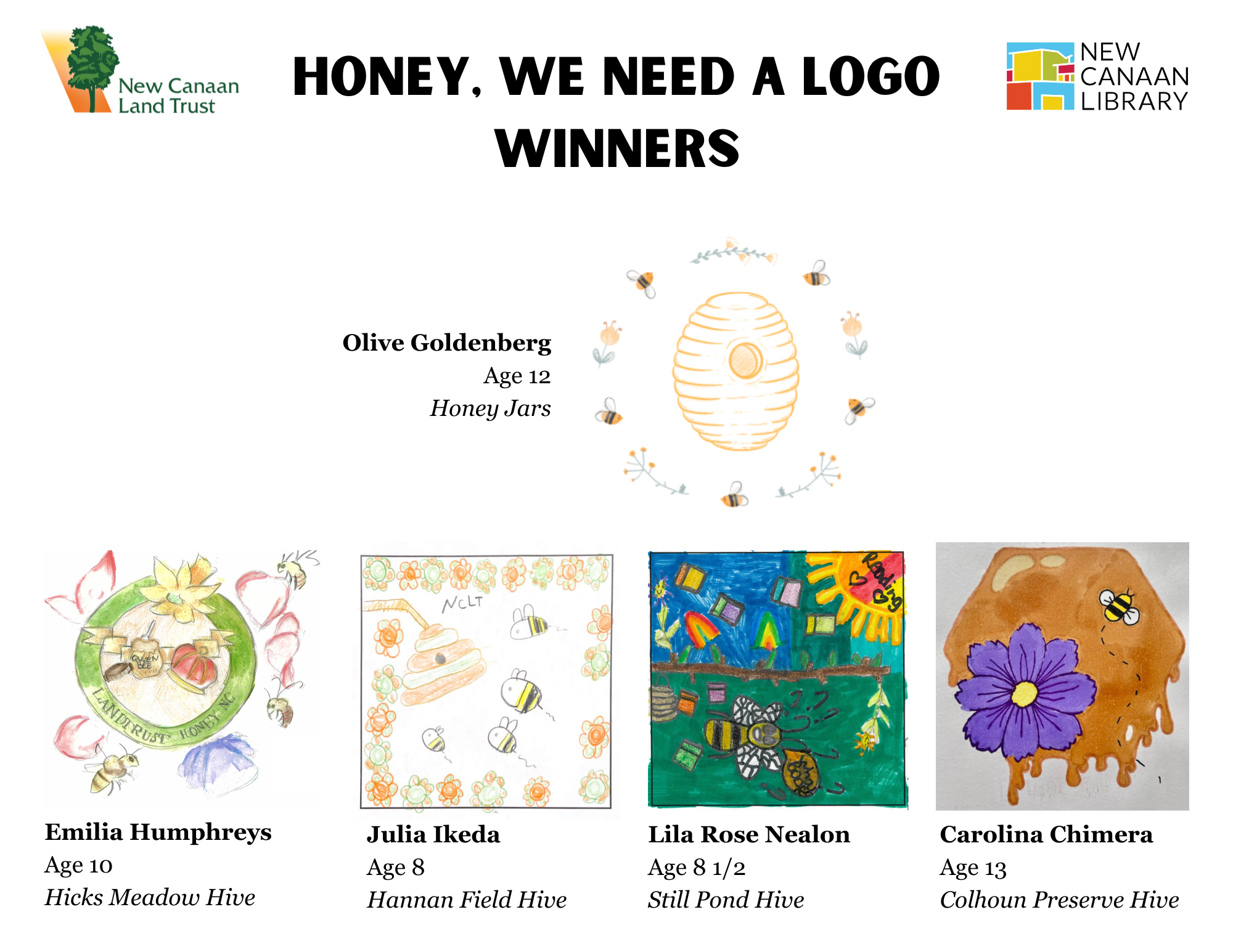
Eagle Scout candidate Jack Winalski and volunteer beekeeper
This year, a ray of hope has emerged in New Canaan in a world bombarded with constant environmental degradation news. What started as a modest proposal to the New Canaan Land Trust has evolved into a community-wide project, buzzing with life and the promise of sustainable change.
How it Started
This tale of community and conservation began in February. A New Canaan resident and beekeeper with four years of experience approached the Land Trust. He proposed to apply his skills, tools, and zeal for beekeeping to benefit the Land Trust and the community.
Not long after, St. Luke School sophomore Jack Winalski came on board. An Eagle Scout candidate with hives in his backyard, Jack was eager to help bring bees to New Canaan Land Trust properties. Our volunteer beekeeper and Jack spent weeks preparing for the endeavor — painting hives, constructing stands, and plotting the locations for the twelve hives that would soon house hundreds of pollinators.
All About Bees
A bee hive that is all full strength, in the late summer when the nectar flow is the strongest, will have around 30,000 to 50,000 bees. The majority of the bees in a hive are female. Bees hold many jobs over their lifespan (around 30 to 45 days), including nursing the young, foraging for pollen and nectar, bringing water into the hive, and guarding the hive entrance from predators.
Each hive has one queen, whose only job is to lay eggs. In the spring when the population is growing, she will lay up to 1,500 eggs per day. Male bees, called drones, assume the sole job of breeding with the queen. Drones’ tenure is short: the female workers remove them from the hive at the end of the fall.
A well-maintained hive can produce 50 to 75 pounds of honey per year. Our twelve hives have yielded around 300 pounds of honey.
Community Engagement
The bee initiative wasn’t contained within a small circle of enthusiasts. Once the word got out, the broader community became involved. A partnership with the New Canaan Library and its Children’s Librarian, Marie Aspinwall, inspired the creation of a community-wide logo design contest. The competition invited participants to design logos for the bee hives and honey jars. Targeted at school-aged children (but open to all), the “Honey, I Need a Logo” contest generated 56 entries. The ages of the participants spanned from four years old to a senior community member!
Olive Goldenberg, 12, clinched the top spot, and her design will grace the honey jars. Runners-up Emilia Humphreys (10), Julia Ikeda (8), Lila Rose Nealon (8), and Carolina Chimera (13) will have their art showcased on the hives. New Canaan CARES jumped in to expand the program’s impact: its CARES Craft Club created educational signs (with the Library) to be placed at each hive site.

Installing the Hives
In April, the plan materialized. Our local beekeeper and Jack installed the twelve hives on four Land Trust preserves – Colhoun Preserve, Still Pond Preserve, Hicks Meadow, and Hannan Field. Observing the installations was nothing short of awe-inspiring. The bees arrived in a “nucleus hive” or a “nuc.” This shoebox-sized box contains a starter hive: a mated queen and 10,000 other bees to start building comb for brood and honey. The bees are moved from the nuc and placed into the permanent hive. Once the bees have a few minutes to settle, they begin their orientation flights, scouting their new surroundings.
The installation produced some drama. At Hannan Field, the bee colony became slightly aggressive when separated from their queen in the nucs. At Hicks Meadow, a wayward queen stuck in the nuc lid led her colony to swarm a tree, requiring a collection method involving a large garbage can.
Sweet Results
The summer concluded with a harvest. Our summer steward interns had the honor of bottling the 300 pounds of honey collected from the hives—the yield: a remarkable 888 honey bottles in 8 oz and 3 oz sizes. This project wasn’t just about bees or honey. The initiative drew various community segments into a unified cause—from our local beekeeper’s and Jack’s intergenerational collaboration to school children unleashing their creativity in art. By combining forces, skills, and passion, we’ve made something extraordinary.
The Future is Sweet
As we look forward to the honey bottling workshop and beyond, it’s clear that this bee initiative has made an indelible impact. It has served to educate, engage, and perhaps most importantly, remind us of the simple yet profound connections between humanity and nature. Our 2023 bee program highlights the rewards of a community collaboration of experienced naturalists, inspired young conservationists, school-aged artists, and many who will enjoy the fruits of their labor.
And as you taste the community-crafted honey, remember: It’s not just sweetness you’re savoring, but the nectar of collective effort, creativity, and love for the natural world.
This article was also published in the New Canaan Sentinel.
Recent Comments